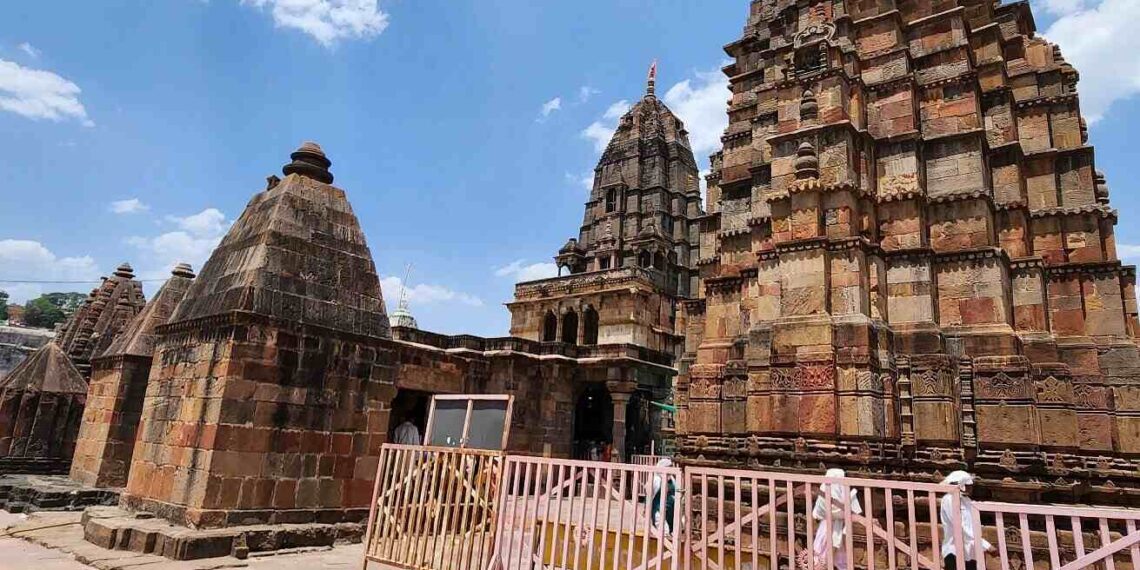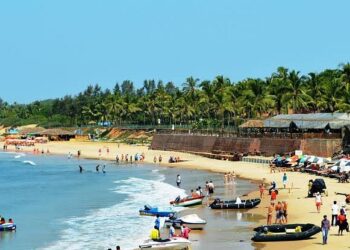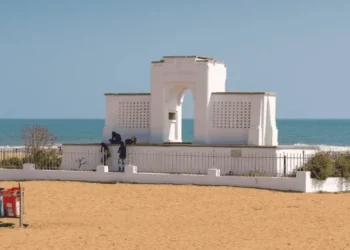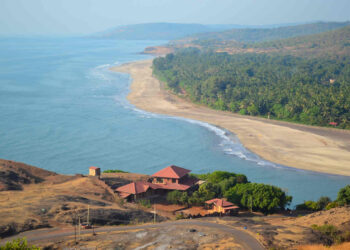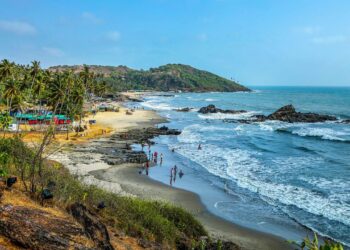Set on the south bank of the Narmada River, across from Omkareshwar’s island in Madhya Pradesh, the Mamleshwar Temple, also called Amareshwar, is a sacred place dedicated to Lord Shiva, tied to the Omkareshwar Jyotirlinga. Built around the 11th century, it is the fourth Jyotirlinga out of twelve Jyotirlingas. The ancient name of Mamaleshwar Jyotirlinga was named as Amareshwar. Mamaleshwar temple is on the south bank of the Narmada, and Omkareshwar Jyotirlinga sits on the Omkar Parvat towards the north bank of the Narmada. Maa Narmada is in the middle of both temples.
Notable Fact: Many believe Mamleshwar and Omkareshwar together form one Jyotirlinga, split by the river.
Shiva Purana Legend
According to the Shiv Mahapuraan, Brahma (the Creator) and Vishnu (the Preserver) once had a disagreement about which of them were supreme. To test them, Shiva pierced the three worlds as an immeasurable pillar of light, the Jyotirlinga. Vishnu and Brahma parted company to determine the extent of each end of the pillar. Brahma, who had set off upward, lied that he had discovered the upper end of the pillar, but Vishnu, who had gone in the direction of the base of the pillar, admitted that he had not. Shiva then appeared as a second Jyotirlinga and cursed Brahma, telling him that he would have no place in the ceremonies. The Jyotirlinga is the supreme indivisible reality from which Shiva appears. Jyothirlinga shrines commemorate this time when Shiva appeared. It was believed that there were originally sixty-four jyotirlingas. Twelve are considered to be especially auspicious and holy. Each of the twelve sites takes the name of the presiding deity and each is considered a separate manifestation of Shiva. At all these sites, the primary deity is a lingam representing the beginning less and endless Stambha pillar, symbolizing the Shiva’s infinite nature.
Mythological Significance
According to folk belief, Maharishi Bhrigu meditated here. A Kinnar girl by name Mamlesha used to serve him. This girl was endowed with modesty. Mamlesha Tal was also formed here with the same name. Sage Bhrigu became fascinated by this Kinnar girl Mamlesha. The sage married the girl. Mamlesha fell pregnant to the sage. The sage worshipped Mahakala Shiva to avoid the defect in marriage to a mleccha girl. This is how Shiva was established here. From the name of the Kinnar girl – Mamlesha – Shiva was called Mamleshwar and this village became famous as Mamel.
According to folk belief, this temple witnessed Satya Yuga, Treta Yuga, Dvapara Yuga and now Kali Yuga. It is a sacred place where Rishi Bhrigu meditated. During the exile period, the Pandavas constructed the outer part of the temple. A demon was living nearby in a cave. The villagers were bound to send one person daily as a food for the demon. One day a mother was weeping because that day it was the turn of her son. At that time, the Pandavas were guests of that house. Then Bhima told the mother not to worry about it. He told, “I will go to the Demon”. In the battle with demon, Bhima killed him in a place called “lyad” and returned. Then the Pandavas made an akhand dhuna (eternal fire) in memory of this victory and the demon got moksha.
Architecture of Mamleshwar Temple
Mamleshwar Temple sits on half an acre by the Narmada, made in Nagara style. The main part has a low spire, carved with Shiva’s trident, snakes, and lotus blooms, all in gray stone. Inside, the Mamleshwar linga, black and smooth, rests in a brass pit, lit by ghee lamps. The inner walls got plain stone with old prayers.
A small hall has six pillars, carved with gods and river fish. Lesser shrines for Parvati, Ganesh, and Kartikeya stand in the yard, made of stone. The Parvati shrine shows her sitting, for peace. The Ganesh one, from 1400, has him with sweets, for smarts. The Kartikeya one shows a peacock, for might. The stone yard feels holy, by the river. A plain gate has Shiva’s form. A water ghat, Narmada’s edge, is for ritual dips. Pillars tell Shiva’s stories, guiding those who pray. The river’s murmur adds calm.
Rituals and Festivals
Maha Shivratri, in February, is the grandest festival, with all-night chants and milk pujas. Shravan, in July or August, sees daily linga baths with water. Diwali, in October or November, lights lamps for joy. Kartik Purnima, in November, pulls pilgrims for Narmada dips. Nag Panchami honors Shiva’s snakes.
Each day starts with Mangla Aarti at 5:30 AM, offering water. Abhishekam at 7:00 AM uses milk. Evening aarti at 7:30 PM has lamps. Special prayers, like Rudrabhishek, cost ₹100–400 and give blessings. A stall hands out free tilak for prasad. Mondays, people bring bilva leaves for strength and calm.
Information for Travelers
Hours and Entry: Open every day, 5:30 AM to 9:00 PM. It’s free to enter, but prayers cost ₹100–400. No pictures in the inner room.
Clothing: Wear clothes covering shoulders and knees. Women for prayers wear sarees or suits, men wear dhotis.
How to Get There:
Air: Indore Airport, 77 km off, is closest. Taxis take 2 hours, cost ₹1500–2500.
Train: Omkareshwar Road Station, 12 km away, links to Indore (2 hours).
Road: Buses from Indore (2 hours) come to Omkareshwar. Walk or boat (₹50) from Omkareshwar island.
Best Time to Visit:
October to March is cool, 20–30°C. Weekdays are calm. Maha Shivratri’s busy, so plan early.
Nearby Attractions:
Omkareshwar Jyotirlinga, 1 km away, is the twin shrine.
Gauri Somnath Temple, 2 km away, has a tall linga.
Siddhanath Temple, 3 km away, honors Shiva.
Ahilya Ghat, 25 km away, is a Holkar site.
Maheshwar Fort, 30 km away, is a river fort.
Final Thoughts
Mamleshwar Temple in Omkareshwar, Madhya Pradesh, a sacred place in India’s heart, is a treasure for the soul. Lord Shiva’s mighty touch fills all who come, making it a spot you must see among India’s holy sites.
